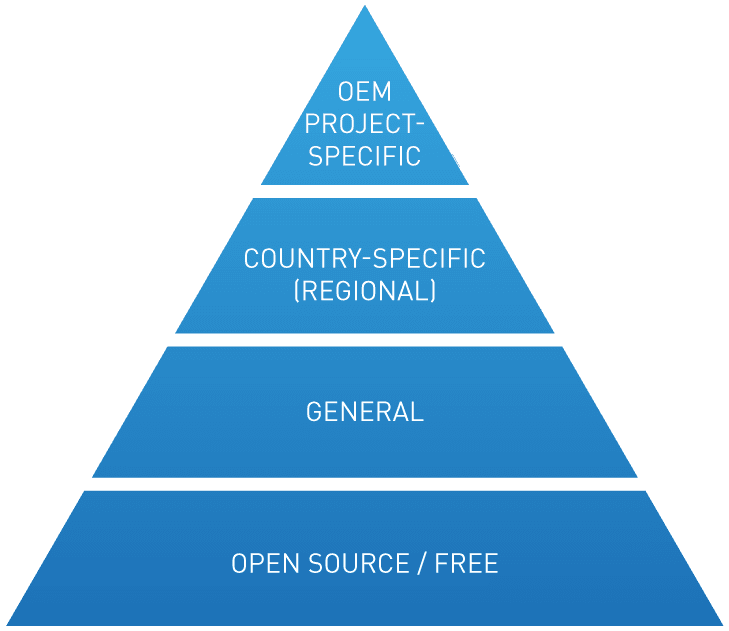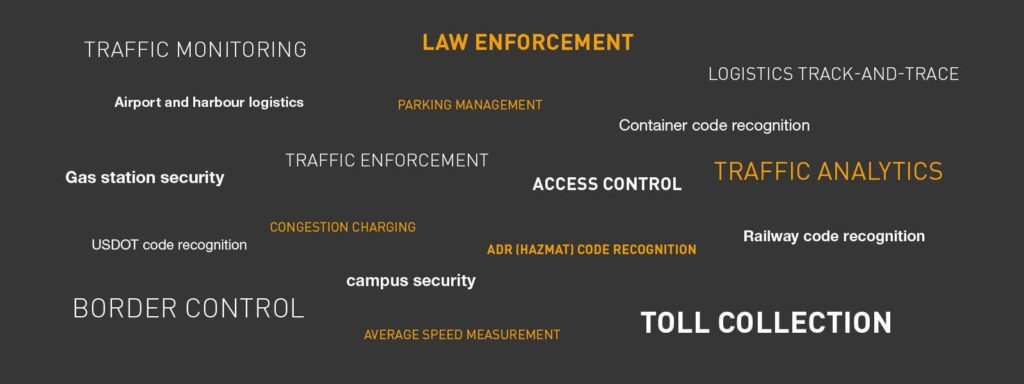
The Problem With the Single ANPR Solution
Many software manufacturers offer a single solution – or a limited number of solutions – for all fields of use. There is no room for customization or tailor-made variants. Automatic Number-Plate Recognition (also known as LPR for License Plate Recognition or ALPR for Automatic License-Plate Recognition) is performed by a software product that is often treated as single and unchangeable. Instead, Carmen® Cloud ANPR solution, an original product developed and manufactured by Adaptive Recognition, has many versions – ANPR engines – optimized for a specific region or country.
This article is going to examine the pros and cons of general vs country-specific ANPR engines and consider the advantages and potentials of tailor-made ANPR software varieties – specifically developed for a particular company, location, or project.
The Pyramid of ANPR Engines

The pyramid-shaped chart above illustrates several types of ANPR engines. At the bottom of the chart, you see open-source ANPR applications. The broad base of the pyramid shows that open-source ANPR is commonly available, while its position in the bottom row suggests that it tends to rank low in quality and performance – in comparison with other ANPR engines.
Further up on the chart, we find general ANPR engines: they are great for general OCR if you don’t mind that these engines will say nothing about the country, province, administrative division, or district.
Higher up in the pyramid, country-specific ANPR engines are superior in quality to general engines. The logic: you can exclude alphabets, font types, syntaxes, and plate types that are not likely to appear in a given country, region, or continent. With fewer options, plate recognition will be both faster and more accurate.
At the top of the pyramid, we can find OEM ANPR engines. The narrow base of the top triangle shows that they are the least commonly available type of the 4 rows. OEM ANPR engines are not off-the-shelf products: they are made to order, manufactured on demand – developed to accommodate your specific needs and preferences. The question is: will a precision tool work better and give you more added value than a one-size-fits-all solution? What is your optimal choice, with all things considered? Let us go through the key factors, above and beyond your objectives and priorities.
Speed and Accuracy
How fast and how accurate is your ANPR system? That depends on multiple factors: ANPR-optimized imaging, image preselection, system architecture, and ANPR engine properties all play a role. The bottom line: it will be as fast and accurate as its weakest component.
Choice – Based on Image Source
Prime category engines coupled with excellent ANPR-based traffic monitoring cameras will produce the best results. However, if your existing camera is not the best, consider compensating for image quality with a state-of-the-art ANPR engine Carmen® FreeFlow.
Ideal Choice – Depending on the Field of Use

If you just want to gain insight, get experience, and learn the nuts and bolts of plate recognition software, besides, neither speed nor topnotch accuracy is a top priority, then your best bet is probably Open Source ANPR.
When it comes to commercial applications, you will need proprietary ANPR software. For example, in commercial fields of use like vehicle access control in, say, a corporate parking lot, speed is a priority, because you don’t want to see a long line of cars. Accuracy is also important, but we are talking about easy-to-read, close-up plate images of stationary vehicles, so, optically speaking, this is a relatively easy task. Pick a general ANPR engine. In other kinds of commercial and homeland applications like traffic analytics or road pricing – commonly called toll collection –, both speed and accuracy are important: in this case, a country-specific engine will serve you best. In mission-critical applications like border control, you cannot afford to lose data and you also need ultra-high precision. You may want to consider an OEM engine tailor-made for your high-priority project.
As a summary of general vs. tailored ANPR engines, here is an overview of ANPR engine types and their most important differences.
| OPEN SOURCE | GENERAL (GLOBAL) | COUNTRY-SPECIFIC (REGIONAL) | CUSTOM-TAILORED OEM ENGINE (DEVELOPED FOR GIVEN PROJECT) | |
| Free | yes | no | no | no |
| Country/region displayed | no | no | yes | yes |
| Off the shelf | yes | yes | yes | no |
| Typical application area | For educational purposes | Commercial applications, including vehicle access control | Important commercial applications like road pricing or traffic monitoring and lane control | Failproof ultra-high-accuracy close-to-zero false-positive top priority projects including homeland security like border control |
General / Specific / Fully customized
Note that many manufacturers do not offer a proprietary general (global) engine on its own – only country-specific versions. General OCR engines are mainly used for statistical purposes or in application areas where the characters do not conform to standard license plate formats, like reading plates of harbor trucks, airport service vehicles, or the bib numbers of Marathon runners – pure OCR tasks.
Also, note that even general engines can be tailored. They are:
- Trained on actual real-life plate images;
- Designed specifically for a given writing system (Cyrillic / Arab / Chinese etc) and
- Regularly – quarterly – updated.
Specific ANPR Engines
Specific (regional) engines can be customized to meet individual requests in varying degrees.
- They are trained on actual real-life plate images from a given region/country, which improves the speed and accuracy of recognition
- They exclude alphabets, plate types, and syntaxes whose probability in that region is minimal, which in turn further improves speed and accuracy
- Even within the same alphabet, font types may differ from one country to another – consider German vs US zero on vehicle license plates

Fully-Customized ANPR Engines
Fully customized (OEM) engines can be tailor-made to meet individual requests in varying degrees.
- Optionally, they may also exclude specific alphabets, plate types, and syntaxes to improve recognition speed and accuracy
- They can perfectly match project requirements: the engine is created from the integrator’s own documented plate pool, in other words, it is trained on images from actual cameras on the project
- The engine is optimized totally as per customer’s request

Conclusion
At Adaptive Recognition, we have a decades-long advantage of plate recognition technology. Adaptive Recognition Hungary Inc. was among the first software developers to prototype a License Plate Recognition (LPR) engine. The need for tailored OCR first emerged over 15 years ago. We paid attention to market demands – and came up with effective solutions. To this date, LPR engines are flagship products in our portfolio. A recent example is a country-specific engine by special request. This project-based engine had to be trained to achieve a false positive rate (FPR) of less than 1% and an accuracy of 98+%. Challenge accepted; engine delivered.

Find out more about free open-source ANPR software, general and regional ANPR engines, or discuss your specific project needs by contacting Adaptive Recognition’s experts:


